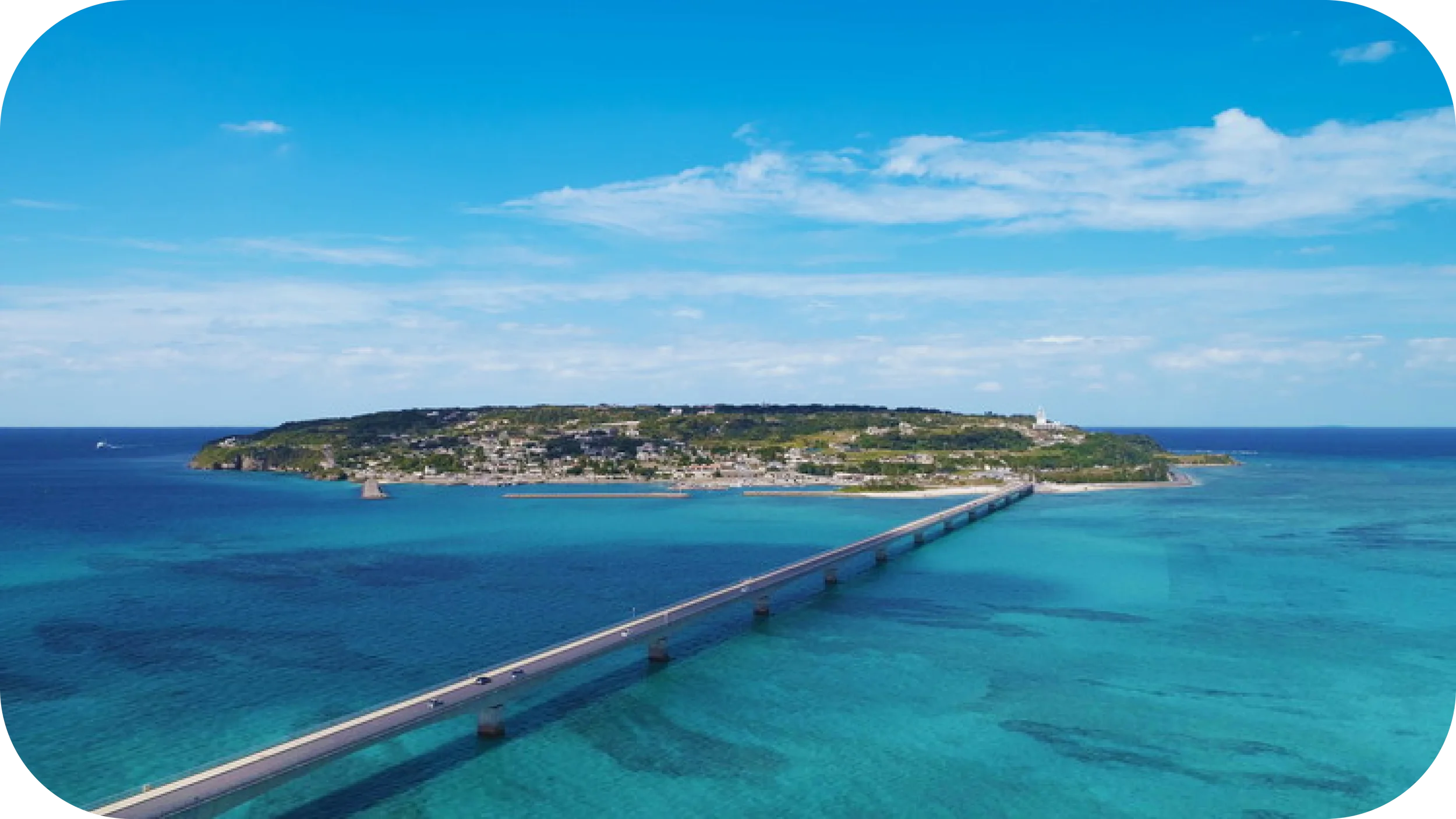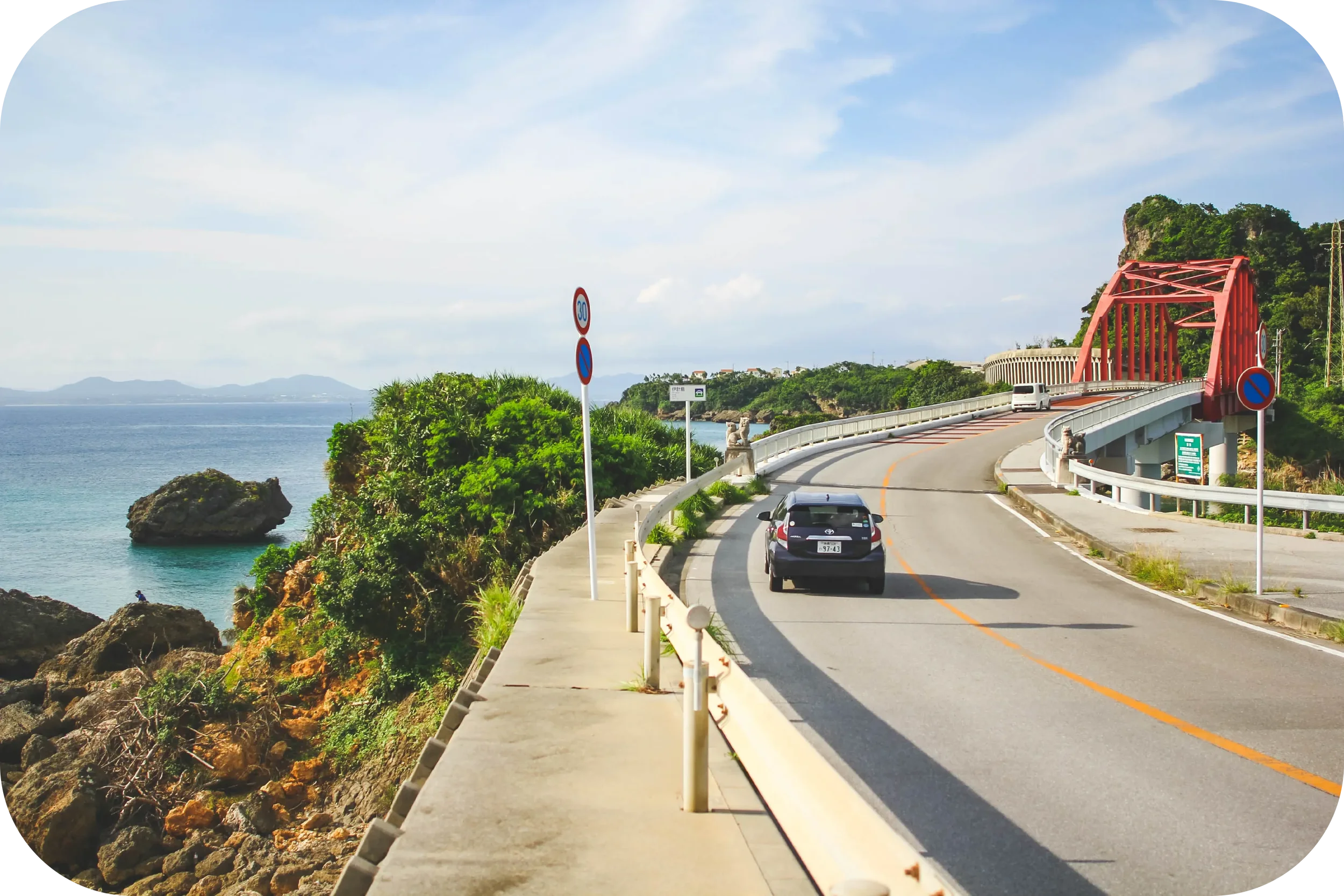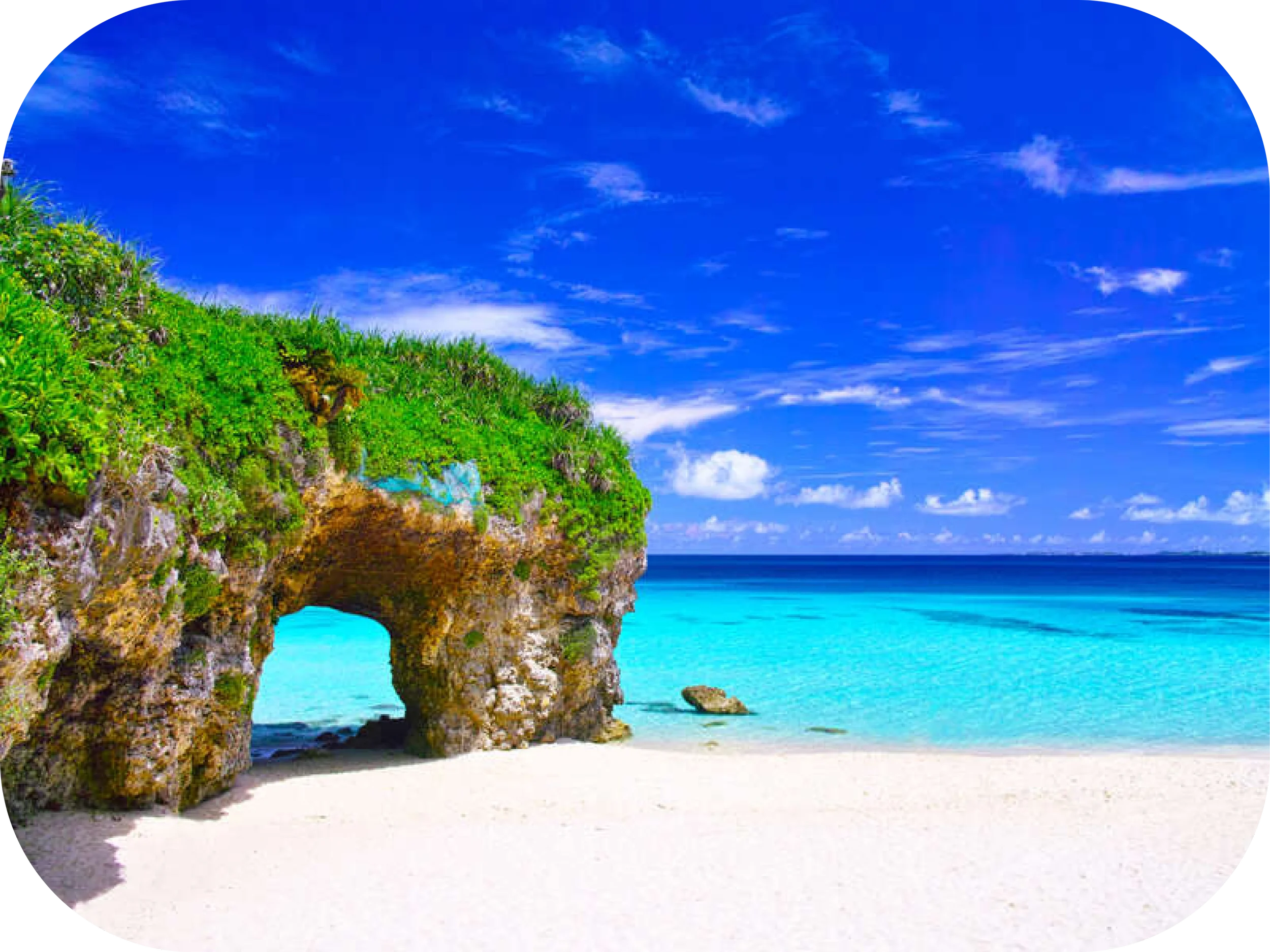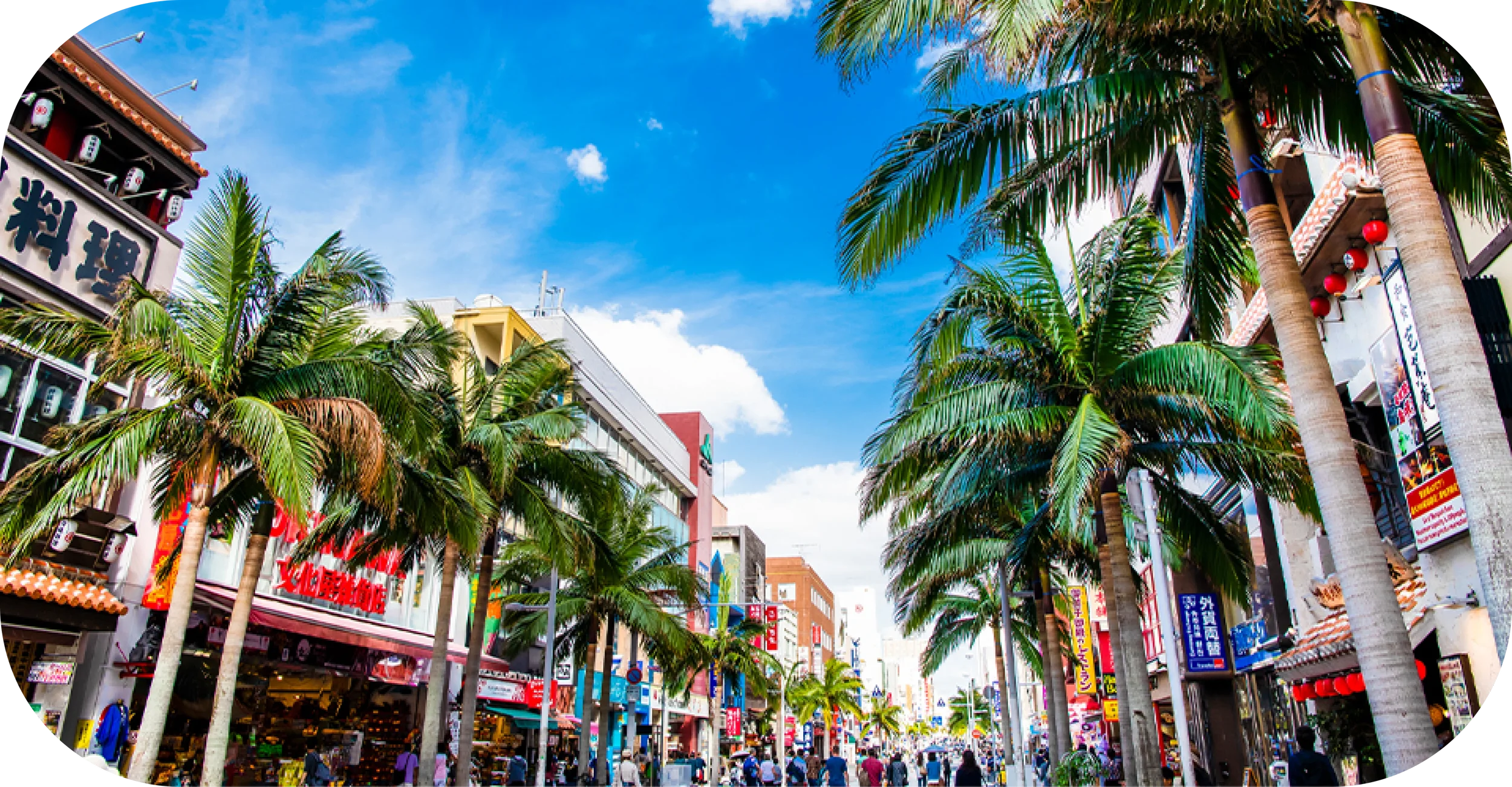Okinawa Travel Planning Guide for 2025
Okinawa’s Main Island offers a mix of pristine beaches, lush forests, and cultural sites – but you need the right plan to maximize your visit. This guide tackles the three big questions for Okinawa travel: how to get around, how much it costs, and the unmissable highlights (with suggested 3–7 day itineraries). We’ll also cover practical tips (seasonal advice, licenses, safety) to ensure a smooth trip. (Last updated Aug 2025 with official sources and on-the-ground insights.)
Quick Answer: What’s the smartest way to get around?
Most travelers find that renting a car is the easiest way to explore Okinawa’s main island, especially if you plan to visit beaches and attractions beyond Naha city. A rental car gives you full freedom and can dramatically cut travel time (e.g. driving Naha to the north takes ~2 hours vs. 4+ hours by bus). However, other options can work for certain scenarios:
- Short stays focused in Naha: Rely on the Yui Rail monorail and local buses. The monorail covers Naha Airport to Shuri (15 stations, including Kokusai-dōri downtown), and a 1-day unlimited pass costs about ¥800 for adults. Buses reach many sites (and accept the local OKICA IC card), though service to rural areas is infrequent.
- No driving permit or traveling solo: Consider guided tours or private drivers. Full-day bus tours to popular spots like Churaumi Aquarium and Cape Manzamo run about ¥5,000–¥10,000 per person, while an 8-hour private car+driver charter (fits 3–9 people) starts around ¥50,000+ per day.
- On a tight budget: It’s possible to get around with a combination of monorail + bus passes and occasional taxis. A one-day Monorail+Bus combo ticket (“Yu-Yu” pass) is about ¥1,000 and covers unlimited Naha transit till midnight. Taxis in town start ~¥600 for the first 1–2 km.
In summary: If you want to see beyond Naha (beaches, aquarium, mountainous north), get an International Driving Permit and rent a car – it’s the smartest choice for most visitors. If you only have 1–2 days in Naha or prefer not to drive, you can stick to public transit or join a tour for key sights.
Transportation Options Comparison
| Option | Pros | Cons | Approx Cost |
|---|---|---|---|
| Rental Car | Maximum freedom; reach remote beaches and Yanbaru forest; faster travel (your own schedule) | Need IDP (foreign license); left-side driving; tolls & parking fees; limited public parking in busy areas | ¥5,000–¥7,000/day (compact car) + fuel/tolls |
| Monorail + Bus | Cheap unlimited passes (monorail ¥800/day); no parking hassle; good for Naha & major spots | Limited coverage outside city; buses are infrequent in rural areas; longer transit times | ¥800 (24-hr monorail pass); ¥1,000–¥2,000/day for local buses |
| Guided Tours | No planning needed; guide provides cultural insights; great if no IDP | Fixed itinerary and timing; less flexibility to linger or explore off-route | ¥6,000–¥10,000 per day trip |
| Taxis & Ride-hailing | Point-to-point convenience; no need to navigate | Expensive for long distances; may be hard to find outside urban areas; ride-share apps limited | ¥600+ base fare in Naha, ~¥5,000 for a 30-km ride |
| Cycling / E-Scooters | Fun for short distances or exploring one neighborhood; no fuel cost | Not practical for island-wide travel; hot humid climate and hilly terrain; some roads unsafe for bikes | Bicycle rentals from ¥1,500/day; e-scooters ~¥4,000/2-day |
Transportation in Detail
Rental Cars (the choice of most visitors)
Rental cars give you the flexibility to see Okinawa’s far-flung sights – from northern cape lighthouses to secluded beaches – on your own schedule. Here are key points to know:
International Driving Permit (IDP): Foreign visitors must have a valid IDP (1949 Geneva Convention type) and your home country license to rent and drive in Japan. Obtain the IDP before you come (usually through your national automobile association).
Exceptions: If you hold a license from Switzerland, Germany, France, Belgium, Monaco, or Taiwan, you can drive with an official Japanese translation of your license instead of an IDP. Note that IDPs are valid for 1 year from issuance and effectively for up to 1 year from your arrival in Japan – Japan doesn’t accept digital or card-format driving permits.Booking & Availability: Reserve a rental car in advance, especially for high season (July–Aug and holiday weeks). Pick-up at Naha Airport is convenient – most companies operate shuttle buses to off-airport lots. In summer, cars can sell out weeks ahead.
Costs & Insurance: A small car runs ~¥5,000–¥6,000 per day before insurance. You’ll be offered CDW (Collision Damage Waiver) for ~¥1,000/day. Even with CDW, you may owe a Non-Operation Charge (NOC) if the car is damaged: typically ¥20,000 if drivable, ¥50,000 if not. Some agencies sell a waiver for NOC.
Driving Rules: Drive on the left side. Speed limits: 40–60 km/h on roads, 80 km/h on expressway. Zero tolerance for drink-driving (BAC limit 0.03%). Seat belts for all passengers; children under 6 must be in child seats.
ETC and Tolls: The Okinawa Expressway runs Naha–Nago. Full trip toll is ¥1,610 cash; ETC card users may get ~¥1,290. ETC cards are often rentable with your car.
Fuel & Parking: Gas ~¥170–¥180/L. Return cars full. Most beaches and attractions have free or low-cost parking; Naha uses coin lots.
Typhoon Plan: If a typhoon approaches, refuel early and park in a safe spot. Communicate with your rental company if plans change.
Local tip: Driving is relaxed, but pull over to let faster cars pass, and watch for animals at night.
Public Transit (Yui Rail & Buses)
Okinawa’s public transit consists mainly of Naha’s Yui Rail and a network of buses.
Yui Rail Monorail: Runs from Naha Airport to Shuri (19 stations, 17 km). Key stops: Asahibashi (bus terminal), Kenchō-mae (Kokusai Dori), Omoromachi (museum), Shuri.
Fares: ~¥230–¥340 one-way. Passes: 1-day ¥800, 2-day ¥1,400. Monorail+Bus “1 Day Passport” is ¥1,000 (expires midnight). Hours: 06:00–23:30.Buses: Serve most populated areas. Examples: Bus #120 (Naha–American Village–Nago), #111 express (Naha–Nago). Fares vary by distance; take ticket on entry, pay on exit. Airport Limousine Buses run to major resorts.
IC Cards: Okinawa’s OKICA works on buses and monorail. Suica/Pasmo cards work on monorail but not most buses.
Coverage Limits: Buses reach major sights but many scenic spots have infrequent service.
Local tip: For resorts north of Naha without a car, the Airport Limousine Bus is convenient and cheaper than a taxi.
Ferries & Island Hops
Kerama Islands (Zamami, Tokashiki) are popular for day trips.
- Boats:
- Tokashiki: Fast ferry ~35–40 min, car ferry ~1h10.
- Zamami: Fast ferry ~50 min, car ferry ~2h.
- Fares: Fast ~¥5,000 return; slow ~¥3,000.
- Booking: Recommended in summer; opens 1 month in advance. Arrive 20–30 min early to collect tickets and fill boarding card.
- Weather: Cancellations possible with rough seas; check morning status.
- On the Islands: Shuttle buses to beaches, rentals for snorkel gear, cash recommended.
- Snorkeling Etiquette: Don’t touch coral or chase wildlife; use reef-safe sunscreen.
Other islands: Ie Island (30 min ferry from Motobu), Kume (ferry or flight), Miyako/Ishigaki (flights).
Local tip: Avoid weekends/holidays for Kerama trips; first out, last back for max beach time.
Tours & Private Drivers
- Group Sightseeing Tours: Full-day bus tours (~¥7,000–¥8,000) cover multiple attractions like Aquarium, Kouri Island.
- Adventure/Niche Tours: Snorkel (¥6,000–¥8,000), intro dive (¥10,000–¥15,000), cultural tours.
- Private Car Charter: 8 hours ~¥40,000–¥60,000 per vehicle; good for small groups, customizable itineraries.
- Taxi Day Hire: ~¥5,000/hour; arrange via hotel.
Local tip: Look for combo tour deals for better value.
Cycling & Scooters
Best for short distances or smaller islands.
- Cycling: Standard rentals ~¥500–¥1,000/hour or ¥2,000/day. E-bikes ~¥3,000/day.
- Scooters: 50cc rentals ~¥4,000/day. Motorcycle license/endorsement often required.
- Safety: Wear helmets, avoid midday summer rides, bring water, watch for traffic.
Local tip: Dockless e-scooters are appearing in tourist zones; rules allow some low-speed models without a license (age 16+).
Budget: What Does a Trip to Okinawa Really Cost?
Below are realistic daily ranges for different traveler types. Prices are per person, assuming sharing costs like accommodation and car rental.
Daily Budget by Traveler Type
| Traveler Type | Transport | Lodging | Food | Activities/Tours | Fuel/Parking | Island Hops | Daily Total |
|---|---|---|---|---|---|---|---|
| Shoestring | ¥1,500 (bus passes) | ¥3,000 (hostel/dorm) | ¥2,000 | ¥1,000 | ¥0–¥500 | ¥0 | ¥7,500–¥8,000 |
| Mid-range | ¥3,000 (car share) | ¥8,000 (business hotel) | ¥3,000 | ¥2,500 | ¥500 | ¥0–¥1,000 | ¥17,000–¥18,500 |
| Comfort | ¥5,000 (private car) | ¥15,000 (resort) | ¥5,000 | ¥5,000 | ¥1,000 | ¥0–¥2,000 | ¥27,000–¥28,000 |
Example 5-Day Trip Total (per person)
| Traveler Type | 5-Day Total |
|---|---|
| Shoestring | ~¥40,000 |
| Mid-range | ~¥90,000 |
| Comfort | ~¥140,000 |
Cost Breakdown Notes
- Transport: Includes rental fees or passes; car rental assumes sharing costs.
- Lodging: Based on double/twin share.
- Food: Mix of convenience store meals, local diners, and mid-range restaurants.
- Activities: Entrance fees, small tours, aquarium tickets.
- Fuel/Parking: Low if staying in one area; higher for north-south driving.
- Island Hops: Adds ferry costs; only included if doing trips like Kerama.
Money-Saving Tips
- Travel in Shoulder Weeks: Late May–early June, late Sept–early Oct for good weather and lower prices.
- Stay Outside Naha: Basing in Nago or smaller towns can be cheaper for longer stays.
- Self-Cater: Cook one meal/day; most hotels have kettles, some rentals have kitchens.
- Free Fun: Many beaches and viewpoints are free; markets and street food can replace restaurant meals.
- Combo Tickets: Look for multi-attraction passes to save on entry fees.
Local tip: Avoid Route 58 traffic at rush hours by using inland roads or traveling early.
Practicalities & Safety
Driving Rules & Signage:
- Drive on the left; speed limits 40–60 km/h (roads) and 80 km/h (expressway).
- Watch for blue road signs (directions) and yellow caution signs (curves, animals).
- Zero tolerance for drink-driving (limit 0.03% BAC).
- Seat belts for all passengers; child seats for kids under 6.
Typhoon Readiness:
- Watch forecasts (JMA Typhoon Information).
- Stock water and food; avoid beach or marine activities in warnings.
- Ferry and flight cancellations are common — rebook early.
Heat Safety:
- Wear hats, sunscreen; hydrate often.
- Avoid strenuous activity at midday in summer.
Marine Life Etiquette:
- Don’t touch coral; keep 2–3 m from turtles.
- Use reef-safe sunscreen.
Connectivity & Money:
- SIM/eSIM widely available; free Wi-Fi at major stations.
- Cards accepted in cities, but small shops often cash-only.
What to Book in Advance (and When)
| Item | Lead Time | Notes |
|---|---|---|
| Rental Car | 1–2 months (Jul–Aug) | IDP required; book early in peak |
| Ferries (Kerama) | 1 month | Summer & weekends fill fast |
| Popular Tours | 2–4 weeks | Snorkeling, diving, cultural tours |
| Select Restaurants | 1–2 weeks | Especially in Naha, Onna resorts |
Local tip: You can usually book buses, small attractions, and most cafés last minute.
Packing & Prep Checklist
- Swim/snorkel kit
- Reef-safe sunscreen
- Rain jacket/poncho
- Car chargers & power bank
- Motion-sickness pills (ferry days)
- Compact cash stash (~¥10,000 in small bills)
- Hat, sunglasses
- Light long-sleeve for sun protection
Local Tips (Save Time & Money)
- Parking hacks: Look for 24h coin lots in Naha; at beaches, arrive before 10 am for free spots.
- Early starts: Avoid Route 58 traffic jams.
- Gas timing: Refill before returning rental; nearest to airport is JASS fuel station.
- Convenience store essentials: Onigiri, drinks, sunscreen, beach mats.
- Avoid 58 at rush hour: Use inland roads where possible.
Responsible & Respectful Travel
- Leave no trace: Take rubbish with you; some beaches have no bins.
- Wildlife respect: Keep distance from sea turtles, birds, and wild boar.
- Cultural norms: Remove shoes when entering homes or traditional inns.
- Noise: Keep voices down at night, especially in rural or camping areas.
How This Guide Was Made (E-E-A-T)
This guide was written and updated by a local Okinawa-based travel writer with firsthand experience driving, ferry-hopping, and exploring every corner of Okinawa’s main island.
All pricing and operational details were last verified in August 2025 using official tourism, transport, and operator sources.
Data Sources Include:
- Okinawa Prefectural Government Transport Information
- Yui Rail official website
- Ferry operators for Kerama routes
- Okinawa Tourism Board seasonal advisories
FAQ
Q: Do I need an International Driving Permit to rent a car in Okinawa?
A: Yes — unless you have a license from Switzerland, Germany, France, Belgium, Monaco, or Taiwan with an official Japanese translation. IDP must be obtained before arrival.
Q: Is public transport enough, or do I really need a car?
A: For Naha-only trips, public transport is fine. For beaches, aquarium, and north Okinawa, a car saves hours.
Q: How much cash do I need? Are cards widely accepted?
A: Cards are common in cities/resorts, but rural shops and small eateries may be cash-only. Keep ~¥10,000 cash handy.
Q: What is the best month to visit for beaches vs. fewer crowds?
A: June and October have warm water and lighter crowds. July–Aug is peak season (also typhoon risk).
Q: Are there tolls and how does ETC work?
A: Okinawa Expressway toll from Naha–Nago is ¥1,610 cash; ETC card users may pay less. ETC lets you drive through toll gates without stopping.
Q: Where should I stay — Naha, Onna, or Nago?
A: Naha for culture and transport; Onna for resort beaches; Nago for quieter northern base.
Q: Can I day trip to the Kerama Islands? How early to book?
A: Yes — book ferries up to a month ahead in summer and weekends.
Q: What’s a realistic daily budget for food in Okinawa?
A: ¥2,000–¥5,000 depending on mix of convenience store meals vs. restaurants.
Q: Are there jellyfish or dangerous marine life to worry about?
A: Yes — avoid box jellyfish season (July–Sept) by swimming inside nets; beware of stonefish.
Q: What happens to my plans during a typhoon?
A: Expect ferry/flight cancellations; follow local government safety instructions.
Q: Is parking free at beaches? Any gotchas?
A: Many are free; some charge ¥300–¥500/day. Arrive early for free spots.
Q: Are snorkel rentals easy to find, or should I bring gear?
A: Gear is widely available for rent near popular beaches.
Q: How safe is night driving on the island?
A: Generally safe, but watch for animals and unlit rural roads.
Q: What are good rainy-day activities?
A: Okinawa World, Churaumi Aquarium, museums, large malls like AEON Rycom.
Q: Is English widely spoken in tourist areas?
A: Basic English is common in hotels and major attractions; less so in rural areas.
Last Updated: August 2025





